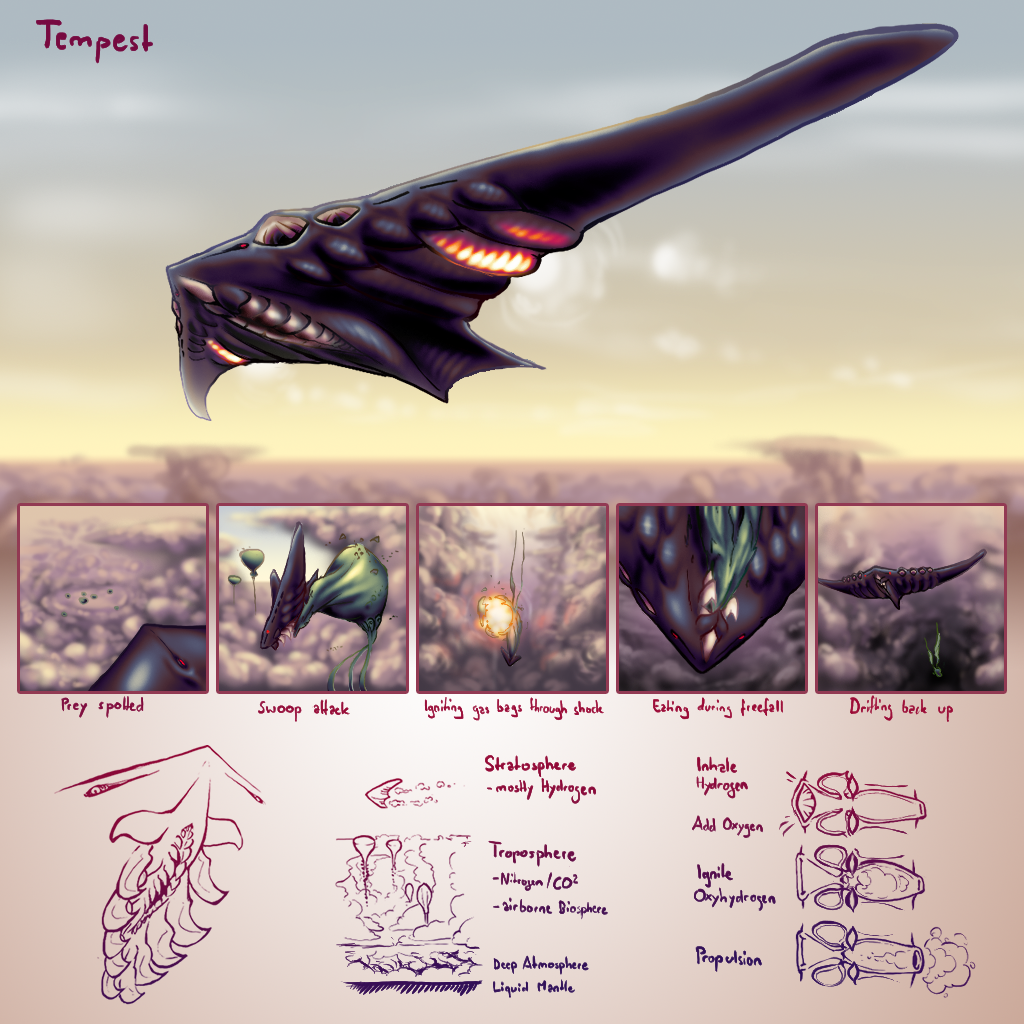
Soaring high above the cloud layer of the Neptune-sized gas giant Pazuzu, the Tempest is the largest and most feared predator of its airborne ecosystem.
Other than its prey, the island-sized Balloonettes, Tempests aren’t limited by the tropopause and can reach high into the planet’s hydrogen stratosphere on the lookout for potential prey. Once located, the Tempest will begin to nosedive towards the target, using the high gravity of Pazuzu combined with their considerable size to reach supersonic speeds during the descent. They use these speeds to tackle their rather slow prey and dig their rows of self-sharpening claws lining their mouth deep into the prey’s gas bags. These claws interlock in their resting position, sheering against each other which keeps them sharp.
To prevent the prey from struggling, the Tempest ignites the hydrogen in the Balloonette’s gas bags through an electric shock. It then gorges on its prey during freefall through the several hundred-kilometer-thick troposphere. Before it reaches the acidic deep atmosphere, it lets go of the carcass and drifts back up by filling small hydrogen bladders across its gigantic body for buoyancy. On its way back to the stratosphere, it digests its meal. It also uses the dive into the troposphere to fill up on CO2 and oxygen which it needs to fuel its photosynthesis, cellular respiration, and propulsion in the upper atmosphere.
While Balloonettes rely on hydrogen purely as a lifting gas, Tempests use it in combination with oxygen to fuel their biological pulse engines. These propulsion organs evolved from the gas bags of their gliding ancestors. The electrolysis organs which originally produced lifting gas now function as a row of igniters, setting off one chamber at a time. They inhale hydrogen straight from the stratosphere and mix it with oxygen produced by the photosynthetic cells on their broad back to create highly explosive oxyhydrogen. With this novel form of propulsion method, they are able to achieve astounding speeds in flight. By firing all eight propulsion chambers at once, they are also able to lunge forwards.
During coasting, the sequential knallgas explosions can be heard for miles like dreadful war drums. Tempests use these rhythms to locate potential mates and keep potential competition at bay. Researchers have described it as “birdsong with canons,” with fast, loud rhythms serving as a display of virility.
Once a tempest has found a mate, the male tries to impress the female during a free-diving race through the clouds, sometimes even into the dense and acidic lower atmosphere. She not only tests his skill as a hunter but also his dedication. If he proves himself worthy, they then mate during the ascend back through the troposphere.
The young stay with their mother for the first few years until they grow large enough to hunt smaller atmospheric life themselves. As juveniles, the pair of fins in front of their mouth can still be used to grapple onto things and climb inside the pouch-folds between the mother’s tail and abdomen.
This entry was made by Captain Stroon.
Author’s note: The Tempest is highly inspired by Edwin Salpeter and Carl Sagan’s Jovian Ecology, as well as Wayne Barlowe’s Skewers. The former was one of my first encounters with speculative evolution and I’ve been fascinated with gas giant biospheres ever since.